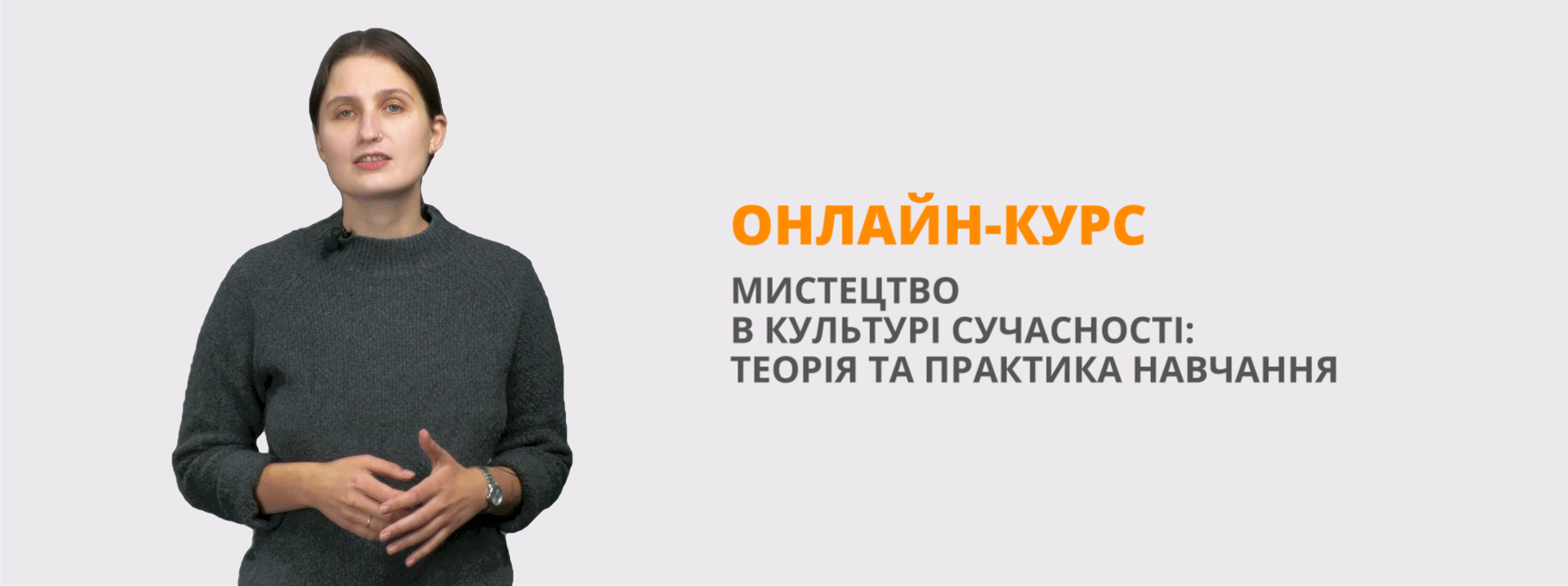Конспект уроку для 11 класу з факультативного курсу "Ділове англійське спілкування" на тему: "Гроші".
Урок з факультативного курсу "Ділове англійське спілкування"
Конспект уроку в 11 класі
Учитель Сергєєва О.О. НВК «Загальноосвітня школа-ліцей інформаційних технологій» №69 м. Маріуполь
Тема уроку: Систематизація і узагальнення знань і навичок за темою "Money", захист проекту.
Мета та задачі уроку: Організувати монологічне мовлення учнів у зв'язку з ситуацією, усне тренування учнів з оперування граматичним матеріалом на рівні речення,читання тексту вголос, усне тренування учнів з оперування лексичним матеріалом на рівні речення; інтегрувати знання з інших навчальних предметів, узагальнити знання за темою - захист творчого проекту.
Розвивати мовленнєву реакцію, оперативну пам'ять, здібність самостійно планувати мовленнєвий вчинок, слуховий контроль, вміння логічно, послідовно викладати думки іноземною мовою; удосконалювати якість навичок вимови; розвивати культуру читання; розвивати творчу компетентність: логічне мислення, здібність до здогадки, уяву, уміння порівнювати, узагальнювати вивчений матеріал, розширювати між предметні зв'язки.
Виховувати свідоме ставлення учнів до вивчення іноземної мови, формувати світогляд учнів, розуміння іноземної мови як засобу міжнаціонального спілкування.
Тип уроку: урок - презентація за темою "Money".
Засоби навчання: Підручник Oxford Business English M.Tulip "ProPile", роздавальний матеріал ( картки, тестові питання, форми оцінювання проекту ), технічні засоби ( комп'ютер ), політична карта світу, наочність (валюта різних країн ), творчі проекти.
Місце проведення:Кабінет англійської мови.
Методи навчання: Інформаційний, дослідницький, проблемний, пояснювально-ілюстраційний, практичний. Метод наочності, бесіда, розповідь, самостійна робота.
Форми роботи: Пояснювально- дослідницька, робота з різними джерелами інформації, створення проблемних ситуацій, дискусія, парна, групова, фронтальна робота, контроль і самоконтроль.
План уроку.
І. Підготовка до сприйняття іншомовного мовлення.
Привітання - Greeting.
Привітання з класом, перевірка готовності учнів до уроку,бесіда з черговими.
(2 хвилини)
Мовна розминка - Warm-up.
Мотивація знань учнів. ( 7 хвилин )
Test ( 3 хвилини )
II. Основна частина уроку:
Ознайомлення з темою й метою уроку, перегляд питань і рекомендацій щодо створення проекту. ( 4 хвилин )
Представлення учнями творчих проектів-презентацій за темою "Money". ( 20 хвилин )
III. Заключна частина уроку.
Підбиття підсумків уроку – Summarizing
Заповнення форм оцінювання аспектів проекту. ( 2 хвилини )
Обговорення проекту, виставлення загальної оцінки. ( 5 хвилин )
Пояснення домашнього завдання - Homework. ( 2 хвилини )
Закінчення уроку - Saying goodbye.
Хід уроку.
І. Підготовка до сприйняття іншомовного мовлення.
Привітання - Greeting.
Привітання з класом, перевірка готовності учнів до уроку,бесіда з черговими.
Т. Good morning, nice to meet you.
P. So we do.
T. Sit down, please. Let's start our lesson.
Мовна розминка - Warm-up. ( Мотивація знань учнів ). Діалог у режимі вчитель - учні
Т. By the way, I have a little problem too. Yesterday while shopping I suddenly understood I couldn't control my money quite rigidly. I consider sometimes it is very difficult to control money, if you are spending in small amounts over a period of time, so realize that it does build up to quite a large amounts. So I have to keep track of what I am spending on a regular basis. Could you give me advice how to manage money?
P. You'd better to sign a customer's bank account, a set of records showing all the money received and paid out. And if with your credit history everything is all right the bank will be able to give you a credit card.
T. What does a credit card mean?
P. It is a small plastic card that you can use to buy goods and services and pay for them later.
T. Oh, I see. It's like a debit card.
P. It's almost the same, but a debit card can be used to take money directly out of your bank account when you pay for goods and services.
T. Well, thanks. So, when I go shopping I'll be able to pay for large items with my debit or credit card. But how can I have a profit using cash for small purchases?
P. There are many chains of large shops and supermarkets nowadays. So if you are a regular customer you'd better to have a discount.
T. Oh, I've heard about the discount and loyalty cards.
P. These cards are not the same. The discount is an amount of money that is taken off the usual cost of something.
P. And the loyalty card is a card given to customers to encourage them to shop in this store regularly. So each time buying something you collect points which will allow you to have an amount of money taken off goods you buy in the future.
T. I should have as the discount as the loyalty cards, shouldn't I?
P. Yes, you should.
T. And where can I get them?
P. They can be given to you directly by a store. Only that you have to do is to spend the fixed amount of money buying something in this store.
T. Thank you for the help. I see you have enough knowledge about the topic. Would you like to know about your relationship to money? Do you think you control money well or is it something you feel uncomfortable with? I've prepared a short test for you. Decide if each sentence is true or false for you. Then count true answers. Are you ready?
Test
I know exactly how much money I have in my purse.
I make sure I leave enough money for emergencies.
I keep the receipt when I buy something.
I usually use the discount or loyalty card.
I prefer buying in up market.
I pay bills on time.
Answers
5-6 true answers:
You have total control over your finances. Perhaps you spend too much time thinking about money.
3-4 true answers:
You have a healthy attitude to your financial affairs. 1-2 true answers:
It's time for you to get organized. An accountant could help you with this.
0 true answers:
You are in trouble. You need help from a financial professional. Get help now!
II. Основна частина уроку:
Ознайомлення з темою й метою уроку.
Our lesson addresses the topics of money and personal banking. It looks at methods of payment, dealing with foreign currency and in particular the euro. During our previous lessons you have studied language and grammar, read about the introduction of money, listened to different conversations about paying for goods and checking bank accounts and collected the information to create your project - presentation "Money". Our task today is to integrate, generalize and present your knowledge about the topic by developing project -presentation.
You got the essential question "What does money mean in your life?" and other questions and recommendations for the work deals with your presentation. I asked you not to forget about language and grammar and recommended to use this material in your project.
( Учитель нагадує учням ключове та тематичні питання, рекомендації по створенню проекту ).
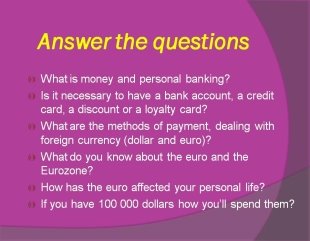
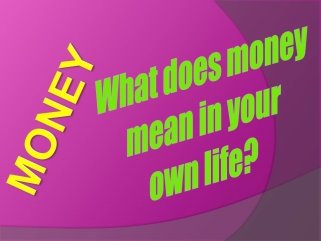
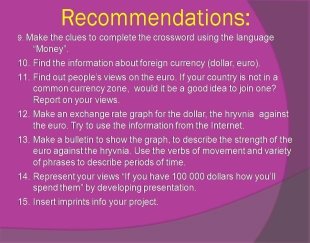
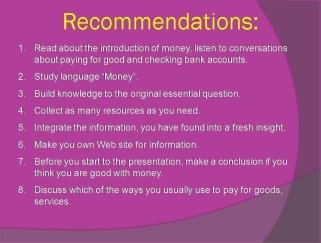
Представлення учнями творчих проектів-презентацій за темою "Money", обговорення проектів.
G.1. The task of our group was to make the presentation "Money". But before we start we've recollected the questions for our project.
G.2. Before doing the publication our group`s studied all language "Money", built knowledge to the original essential question, collected as many resources as we needed, integrated information about topic.
G.3. Our group was preparing Web-site. In order to make it we've discussed its structure, found the information from the Internet and at last created our own Web-site.
P. Our presentation includes 7 slides.

The first slide shows the picture with the name of the topic "Money".
The second "From the history of money" represents the main facts about the appearing of the first coins in Turkey in around the 7th century BC and the first paper money, notes, in China in the 14th century. It describes the invention of modern banking and book-keeping around the same time in Italy. See link in publication.

 P. Our task was to make the report about the history of money. ( учні надають переказ публікації )
P. Our task was to make the report about the history of money. ( учні надають переказ публікації )
P. "Personal banking and methods of payment" tells about the different forms of keeping track of money. We give the examples of the personal banking including such forms of payment as a credit card, debit card, loyalty card and discount. We propose you to know the full information from the bulletin "Credit card inventor dies at 88".
P. Our group had a task to make the bulletin about methods of payment, we called it "Credit card inventor dies at 88". ( учні надають переказ бюлетеню ).
P. Also we created the timeline with key details about the evolution of the credit card, taken from the text, and the table about the cards which were mentioned. You can see them in the screen now. (учні описують таблицю ).
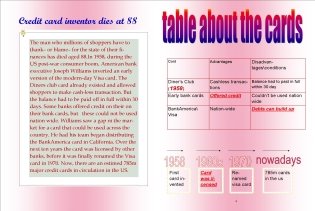
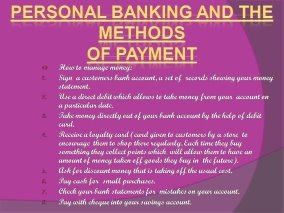
P. And at the end we've made the clues to complete the crossword using the language "Money". Let's try to answer the questions.
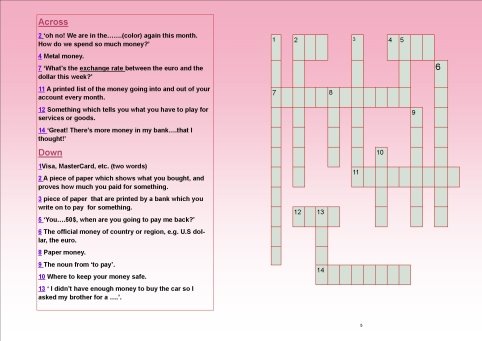
(учні пропонують відповісти на питання кросворду).
P. In the slide "The Eurozone and the euro" our group collected the main facts about the joining first countries-members in the Eurozone in 1950, the Eurozone today and its single currency the euro. 
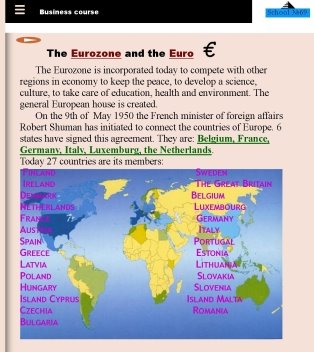 Let's look through this information in Web-site. ( учні описують зміст Веб-сторінки, розповідають про Євросоюз і євро ). ).
Let's look through this information in Web-site. ( учні описують зміст Веб-сторінки, розповідають про Євросоюз і євро ). ).
P. Our task was to tell about the Eurozone and the euro, make an exchange rate graph for the dollar, hryvnia against the euro for the last 6 months.
P. We've made an exchange rate graph for the dollar, hryvnia against the euro. Our report describes the strength of the euro against other currencies. We've looked through the topic "Money" very carefully in order to use the grammar material - the verbs of movement and variety of words, phrases to describe periods of time. ( учні описують діаграму ).
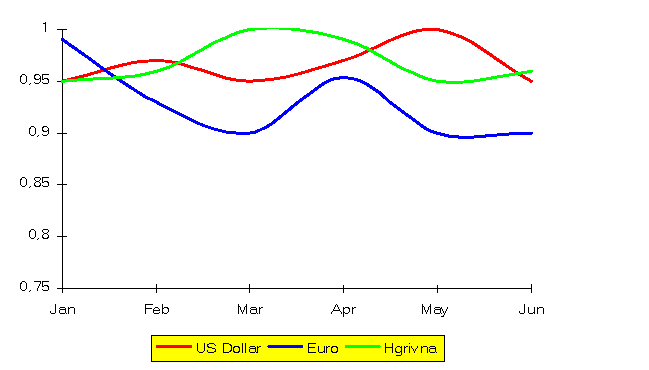 P. The 5 slide shows the people's views on the euro, how it has affected their business and personal lives.
P. The 5 slide shows the people's views on the euro, how it has affected their business and personal lives.
According to Hara, a hotel manage from Crete, the euro has been good for tourism: people like their bills in a familiar currency.
Barry Watson, an international lorry driver from the U.K. says that all his receipts are in euros so doing his accounts simple. He hopes Britain joins the Eurozone soon.
Dagmara Witter from Germany stresses that prices offered by Eurozone countries are clearer and she can lose money because of variations in exchange rate.

P. The question from the 6 slide “ If your country is not in a common currency zone, would it be a good idea to join one? " is addressed to the group of Web-site.
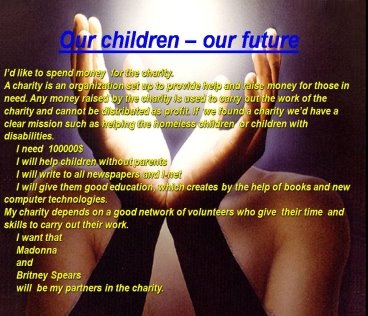 P. We were proposed to discuss the question "If your country is not in a common currency zone, would it be a good idea to join one?" We've compared our thoughts and made a conclusion. Now we report our group's view (учні презентують свої думки щодо питання , пропонують іншим висловити свої думки).
P. We were proposed to discuss the question "If your country is not in a common currency zone, would it be a good idea to join one?" We've compared our thoughts and made a conclusion. Now we report our group's view (учні презентують свої думки щодо питання , пропонують іншим висловити свої думки).
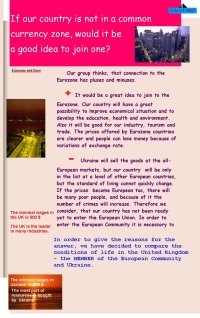
P. And at the end of our presentation the 7 slide gives our group's view on the question '"If you have 100000 dollars how you'll spend them?"
( учні висловлюють свої думки щодо питання, вчитель пропонує іншим групам також відповісти на це запитання ).
III. Заключна частина уроку. Підбиття підсумків уроку - Summarizing
( за допомогою форм оцінювання учні отримують бали за роботу над проектом, вчитель пропонує кожній групі виставити один одному бали за проект, проаналізувати оцінку і порівняти з оцінкою вчителя, висловити свої думки щодо роботи над проектом ).
Пояснення домашнього завдання - Homework.
( Вчитель пропонує учням різнорівневе домашнє завдання з використанням електронних засобів навчання ).
- Make the clues to complete the crossword using the language "Money";
- Make the table about the development of money in Ukraine;
- Make the interpretation of the song “ Money” by the group ABBA.
Закінчення уроку - Saying goodbye.
Захист учнями 11 класу творчого проекту-презентації за темою «Money (Гроші )».
1-4 слайди - ключове та тематичні питання, рекомендації щодо створення проекту-презентації.




5 слайд – тема презентації, слайд містить звук та елементи анімації.

6 слайд – «З історії грошей» розповідає про появу перших монет на території Туреччини у 7 сторіччі до н.е. та перших паперових грошей у Китаї у 14 сторіччі. Учні описують історію створення перших бухгалтерських документів, зародження банківської справи у той самий час в Італії.
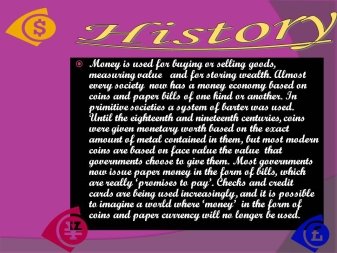
7 слайд – «Сучасні засоби розрахунків» дає поради щодо економії грошей під час розрахунків за товари та послуги. Учні наводять приклади використання різних видів розрахунків: кредитні, дебітні, дисконтні та накопичувальні картки, інформацію про винахідника кредитної картки.
Цей слайд також містить гіперпосилання на публікацію, яка описує ключові деталі еволюції кредитних карток з моменту виникнення і до теперішнього часу.


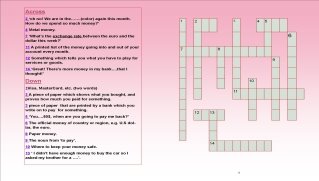
(учні пропонують відповісти на питання кросворду).
На 8 слайді «Єврозона та євро» містяться головні факти з історії створення Євросоюзу у 1950 році, інформація про країни – члени
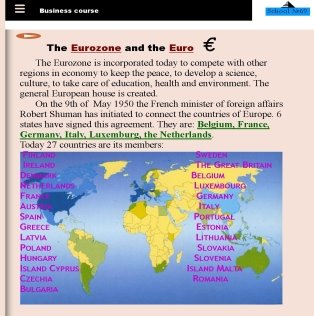 Євросоюзу та про євро - грошову одиницю Єврозони (публікація).
Євросоюзу та про євро - грошову одиницю Єврозони (публікація).

9 слайд «Точка зору щодо євро» показує відношення людей з трьох різних країн щодо використання євро у їхньому бізнесі та у повсякденному житті, переваги та недоліки використання євро, співвідношення цієї грошової одиниці до іншої валюти - долару.

На 10 слайді «Якщо ваша країна не є членом Єврозони, чи буде гарною ідеєю приєднатися до неї?» учні презентують свої думки щодо цього питання, пропонують іншим також висловитися «за» чи «проти».
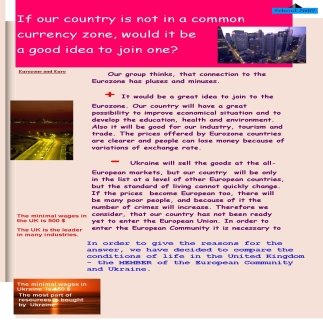
11 слайд «Якщо б ви мали 100000 доларів, як би ви їх витратили?» надає думку групи про укладення грошей у справу своєї мрії – благодійну організацію «Наші діти – наше майбутнє».
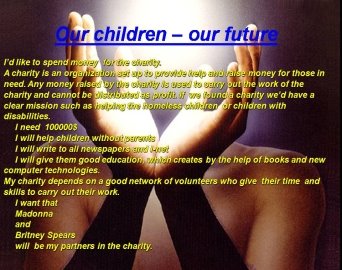
(за допомогою форм оцінювання учні отримують бали за роботу над проектом, вчитель пропонує кожній групі виставити один одному бали за проект, проаналізувати оцінку і порівняти з оцінкою вчителя, висловити свої думки щодо роботи над проектом ).


про публікацію авторської розробки
Додати розробку
